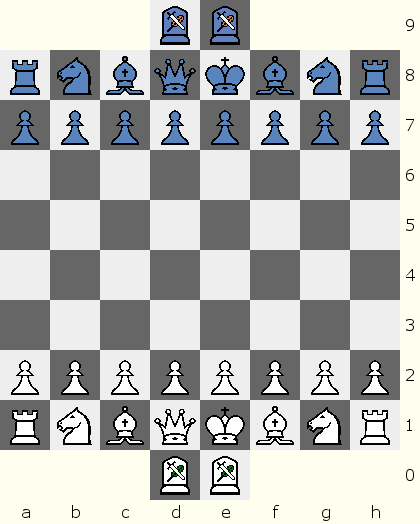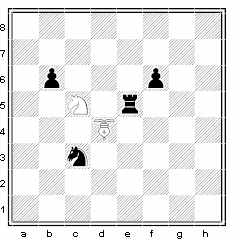Palace Ninja Guards
This game explores the idea of extending the standard 8X8 chessboard to accommodate a pair of new pieces. At the very least, this could be an interesting diversion from orthodox chess.Two Ninja Guards occupy the rear of the palace which consists of two squares protruding from each side's back rank on the standard chess board.
The ninja guards’ leaping ability and relative strength compliment the knights and bishops very well, and together with the extra squares enhance the strategical and tactical aspects of the existing game.Board Setup
 |
Start Position for white (black mirrors this)
Rooks on a1, h1 Knights on b1 and g1 Bishops on c1 and f1 Queen on d1 King on e1 Ninja Guards on d0 and e0 |
The Ninja Guard’s Moves
The Ninja Guard is a color bound piece that can move one or two steps diagonally. It can leap over a diagonally adjacent friendly piece to land exactly 2 squares away (a two-space diagonal leap). It can capture on any square it lands, and additionally it can can capture an enemy piece that is diagonally adjacent by jumping over it. It can capture two pieces (the first immediately adjacent to it, and the next right after) in its path on a diagonal by jumping over the first one and capturing the second piece on the square it lands. |
The Ninja Guard on d4 can capture all the pieces in the diagram.
It can capture the pawn on b6 by jumping over the knight at c5. It can capture the knight on c3 by moving to c3 or by jumping over the knight and landing on b2. It can capture the rook on e5 by moving to e5 or it can capture both the rook and the pawn by jumping over to f6. |
Rules
The rules in this game are identical to chess, except that pawns can now promote to Ninja Guards if desired.Optional Rule - Capture the Scepter
If desired, the game can be played with the following rule:
In addition to the usual way of winning by checkmate,
any side can also win by moving its king to the opponent's rear side of the
palace (the squares: d9,e9 for white or d0,e0 for black) without being captured i.e. if the squares are not protected by the
opponent's pieces. The reason is that there is a scepter located at the rear of the palace (on any of the two protruding squares)
and if retrieved by the opposing king results in an immediate loss!
So the endgame now will involve additional strategy in trying to prevent your opponent from capturing your scepter while
trying to capture your opponent’ scepter.
Since the usual rules of stalemate, 3-move repetition apply, the use of the opposition is key here.
Strategy Ideas
The two squares in the middle can be used as a safety area for the king in certain cases, and instead of castling, the king can be tucked in the rear of the palace. This might be useful when the center is blocked and the opponent has already castled making a wing attack very feasible.The relative values of the ninja guards are quite close to the bishop or the knight. On an open board, the bishop has more mobility, but on a more crowded board, the ninja guards are as powerful as a knight.
Play
Play a game of Palace Ninja Guards Free Registration required at chessvariants.org
 Download Zillions of Games File
Download Zillions of Games File
Click here for the first 12 moves of a sample game.
|
If you would like to email the chess variant inventor directly: inventor@chess.computerwebservices.net
|
|
Posted by: Chess.com on 2022-05-03 19:25:22 Like Chess: YES
Did u see King of the Hill on chess.com? |

